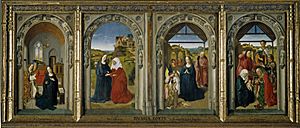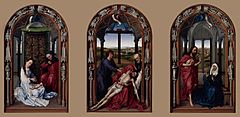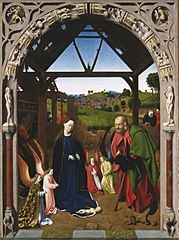Triptych of the Virgin's Life (Bouts) facts for kids

The Triptych of the Virgin's Life is a famous painting by the artist Dieric Bouts. He was an Early Netherlandish painter, meaning he worked in the Netherlands during the early Renaissance. This artwork is a "triptych," which is a painting made of three panels joined together. Bouts created it around the year 1445. Today, you can see this beautiful painting at the Museo del Prado museum in Madrid, Spain.
What the Painting Shows
This triptych tells a story using four different scenes from the life of Mary, the mother of Jesus. These scenes highlight her important role in the Christian idea of Redemption, which means being saved from sin.
The four scenes are:
- The Annunciation: This shows the angel Gabriel telling Mary that she will have a baby, Jesus.
- The Visitation: This scene shows Mary visiting her cousin Elizabeth, who is also pregnant.
- The Adoration of the Angels: This part shows angels worshipping baby Jesus after he was born.
- The Adoration of the Magi: This depicts the Three Wise Men (Magi) visiting Jesus and bringing him gifts.
The painting also features special carved doorways, called "sculpted portals." These look similar to those found in another famous artwork, the Miraflores Altarpiece by Rogier van der Weyden.
Some parts of Bouts's painting are very similar to the Nativity painting by Petrus Christus. Because of these similarities, people once thought that Christus might have painted the Triptych of the Virgin's Life. Art experts believe these connections show that Dieric Bouts might have worked with Petrus Christus when he was a young artist.
Related Artworks
-
Petrus Christus, Nativity, a painting with similarities to Bouts's triptych. It is in the National Gallery of Art in Washington, D.C.
See also
 In Spanish: Tríptico de la vida de la Virgen para niños
In Spanish: Tríptico de la vida de la Virgen para niños



